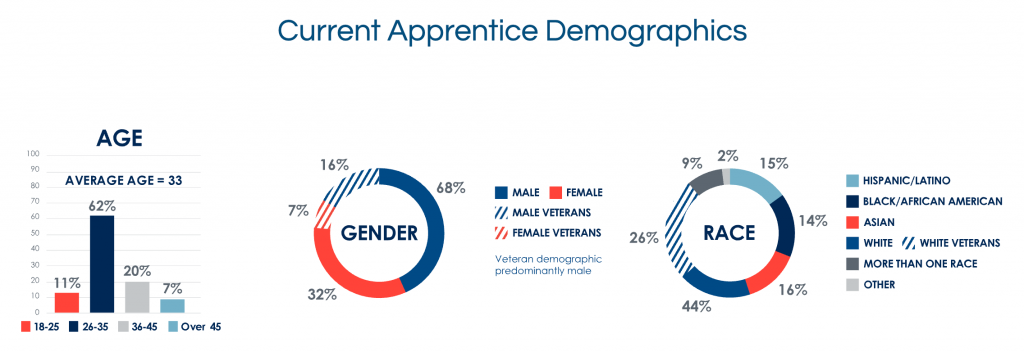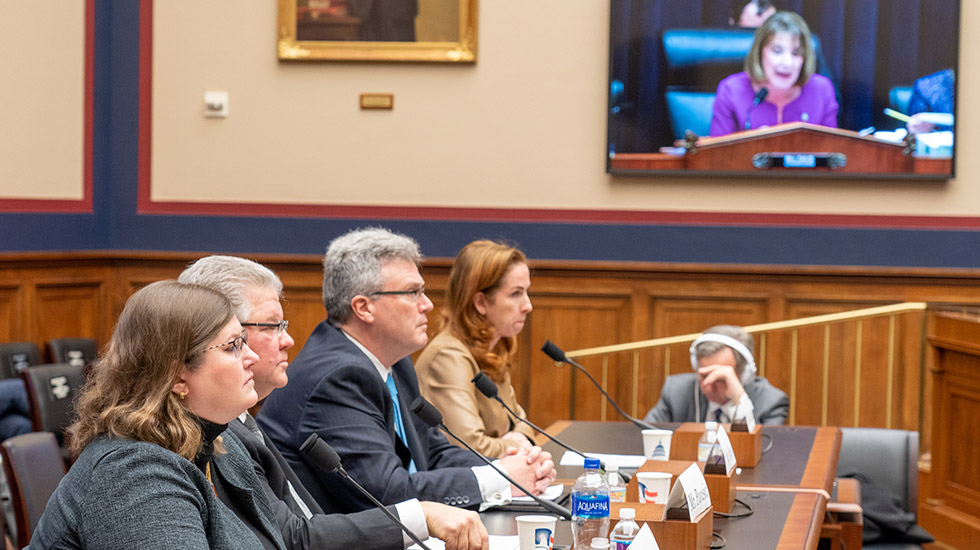The U.S. economy is finally rebounding as America emerges from the sharpest economic ‘V’ in history – a deep recession and a rapid recovery. Within just five quarters, a third of the workforce either changed or lost their jobs during the Covid-19 pandemic. How can employers fill the employment void with qualified talent?

Seattle’s Apprenti may have the answer. It’s called Apprenticeship.
Across this country, the inability to re-train the American workforce, to transform a 20th century wage earner into a 21st century knowledge worker, and to create an on-ramp to accessible, affordable training for the most disenfranchised members of society, has become an existential threat.
Disruption and displacement have alienated workers along cultural and partisan lines. It is too easy for those out of work, unable to find a role in the new ecosystem, to assume they have been made victims and misread what are economic issues as social and political divides.
While there may be no silver bullet for the COVID-19 recession, there is a way to transform our economic future into the kind of gainful employment that can unite Americans around a shared sense of contribution and purpose.
Changing America’s Jobs Future One Person at a Time
The time-honored concept of being taught a skilled profession, not in university but in one-to-one mentoring, must be made a more integral part of our society in order to increase access to quality jobs, especially for young people and communities of color — groups that have suffered the most in employment opportunity as a consequence of recession.
Traditionally, apprenticeships combine on-the-job and classroom training over several years to help people get a foot in the door to the labor market while also increasing access to higher education. They also help meet employers’ needs for a workforce with applied technical and problem-solving skills.
Now the Internet and training-by-design is collapsing the amount of time to place candidates into positions that can be apprenticed and not just inspire, but ensure on-the-job success.
As a standalone system available primarily in the building trades, apprenticeships are not well integrated into the education or workforce training ecosystem more broadly. In 2017, Harvard researchers estimated that apprenticeships could be expanded from 27 to 74 occupations and that we could fill more than eight times the number of job openings with apprenticeships.
It’s no wonder progress has been stalled. The 1937 National Apprenticeship Act governing the formal Registered Apprenticeship system has not been substantially updated in over 80 years. It is not easily adapted for use in many growing industries such as health care and technology.
And yet a robust apprenticeship system has the potential to increase earnings and reduce occupational segregation in the labor market like nothing else can.
The WTIA and the Role of a Lifetime
In 2015, the WTIA stepped into the breach, seizing upon the opportunity to try and connect high tech employers in our region with talented apprentices in the mid-level positions that fill out their org charts. The largest trade association in the state applied for a grant being offered by the U.S. Department of Labor and Apprenti was born.
Thanks to the entrepreneurial imagination and dedication of WTIA CEO, Michael Schutzler, and the extraordinary diligence and vision of Apprenti executive director Jennifer Carlson, Apprenti has quickly become a model for what the apprenticeship picture in 2021 ought to look like and act like in the tech sector.
We caught up with the indefatigable Ms. Carlson via Zoom to register her view of the situation from the team captain’s seat. The sports metaphor is apt. Jennifer was seated in front of a wall of Seattle sports memorabilia from her personal network, including the soccer jersey worn by Seattle star Megan Rapinoe, a baseball bat from the Green Sports Alliance she helped found, and the ice hockey stick Jennifer used to defend her college team as a goalie. Carlson worked with the WNBA’s Seattle Storm before starting her new team at Apprenti. She is still defending a goal — this one for America.
Seattle24x7: What is preventing the wide-scale adoption of Apprenticeship in the U.S.?
Carlson: There are probably three critical things that we have seen that are pain points for companies interested in adopting an apprenticeship program. One has been the policy side. The current federal program started under Obama and it is one of the few programs that gets bi-partisan support. But, not surprisingly, there are different viewpoints on implementation such as how much investment the government should be making. President Biden is full-force positive on registered apprenticeship and moving forward. Not that the previous administration wasn’t. There was just a different view of how it could be run by private companies.
In sectors like IT, it doesn’t make sense to have companies look at apprenticeship individually. What would happen is that it would basically take internships and change the name to apprenticeships. This would not close the talent gap, nor would it offer any economic benefits that would incentivize an employer to change their behavior.
The Registered Apprenticeship system does that! It provides the rigor, the consistency, and the financial incentives for companies to get involved.
Seattle24x7: So there has been a “branding” problem in terms of how the program has been perceived?
Carlson: Right. There was some confusion about this in the previous administration.
The second challenge is that employment law in technology and IT is not steeped in apprenticeship.This is not the case in the building and construction trades.
Apprenticeship provides a “protected wage class” that is federally protected for the term of a particular role. For example, for electricians, it may be five years or 8,000 hours. In most of our tech roles, we are at 2,000 hours or sometimes 4,000 hours, in terms of the protected employment term.
This works two ways: the Apprentice is accepting a lower wage while they are learning and getting a long term audition for the role. And the Company has to provide the support services in the workplace. They can’t terminate unless it is for just cause. It doesn’t fit into “at will” employment decisions. So there is a bifurcated system that may be less attractive to some legal departments.
Apprenti By the Numbers
• Year Founded: 2015
• Number of locations nationwide: 16
• Number of apprentices placed (nationally): 1300+
• Youngest/oldest apprentice placed by Apprenti: 16/65
• Percentage of Apprentices with 4-yr. degree: 52%
• Percentage of Apprentices with 2-yr. degree: 9%
• Average length of classroom training (in weeks): 18-20 Weeks
• Time and cost savings of registered apprenticeship:
- 20-25% cost savings over traditionally sourced talent
- Pay a reduced, federally protected wage while apprentices learn on the job
- Reduce time spent reviewing resumes and interviewing
- Access public and private funding as well as tax credits to support implementation
• Avg. salary while an Apprentice: $54,000
• Avg. salary after Apprenticeship: $85,000
Not All Jobs Are Created Equal
Seattle24x7: This is largely a perception problem?
Carlson: Yes, and it reflects a kind of preconceived notion that these roles typically require a four-year college degree. This impression can also include preferred degree types and even preferred schools.
To counter this requires a bit of a culture shift which is never easy. It requires companies to think more pragmatically about which roles actually require a college degree for hire.
For example, when you think about Data Scientists, those roles are typically PhDs in Math. Are those “apprenticeable?” Absolutely. But ultimately, all you may be doing is poaching a PhD in Math from another company in another industry. That doesn’t solve the talent gap.
By design, Apprenticeship is intended to create another flow of talent, not to compete with colleges but to fill the void on the other side of the aisle.
Let’s face it. Inflating the value of a college degree is artificial. In reality, people who gain certifications and have gone through a more vocational system may also be highly qualified to do the same work. Too many companies think that all jobs are created equal. In reality, they are not.
At one point, Microsoft cited to me directly, “We’re trying to figure out how to characterize an Apprentice. Where is it on the equivalency scale to our college recruit?” Finally, they just said, “We’ve got to throw that playbook out the window and stop trying to figure out how to equate them with college, because they’re not in that group and we need to have a different definition.”
Seattle24x7: So Apprenti does not accept or pre-qualify its candidates by number of years in school?
Carlson: We don’t collect their educational attainment data until they’ve gone through the training process, a company has agreed to sponsor the apprenticeship, and they’re doing their new hire paperwork. We’ve eliminated that from a bias perspective.
Seattle24x7: In retrospect, how does the academic background data sort out?
Carlson: I can only tell you about the 1,350 we’ve placed, not the 25,000 who have applied. 52% happened have a four-year college degree, but more liberal arts, fewer from STEM degrees. 9% had a two-year degree. 5-6% had a high school diploma and nothing else. The delta between the high school and 2-year degrees are people who had taken some classes.
Seattle24x7: Apprenti focuses on recruiting candidates for middle skill level positions. How do you classify these?
Carlson: These are roles that companies have identified for us that are both “apprenticeable” and are the pain points for trying to find talent.
Paradoxically, four-year degrees, Masters degrees, PhDs, are usually in the middle tier. Software Developer through Data Scientist are the more mythical degree types with five years of experience as an entry point.
At the other end of the spectrum, you have the HelpDesk level position. We don’t specialize in that because there are a lot of great programs that already focus on youth and non-degreed individuals coming in for those roles. Frankly those are roles that have a lot more volatility. They can be automated or offshored more often.
Companies have said to us, “Here are the roles where we spend a lot of money to attract talent, typically poaching,” which means raising salary to get people from Company A to Company B. “We know there’s a finite population of people with the degree and 5 years plus of experience, but these sit on the docket as open positions for months at a time.”
These roles include Software Development, Data Analytics, Cyber Analyst, Network Developers, some System Administrator platform jobs and Data Center technicians or Cloud Administrators which is growing pretty rapidly and represents around 20% of our placements now.
Seattle24x7: So how would you characterize the description of a new employee who is a college-degreed individual vs. an Apprenti apprentice?
Carlson: The traditional college folks coming in are well-educated on “theory.” They understand how we got to where we are and what the system mechanics are like. But they don’t have the depth of experience where they can jump in and have an impact when they get there. The company is going to need time to roll them into these jobs and get them that hands-on experience.
The apprentice is coming off of 18-20 weeks of immersive, 40-hour a week, hands-on working with the code. Not touching the full stack, but actually diving in on code, learning the directories, building it out, and ending with a capstone project if they’re on the Software Developer track. They’re ready to hit the ground running, but don’t have the theory knowledge – the opposite side of the coin essentially.
What we’re figuring out with employers is that if you’re going to recruit “x” number of college students, you should have an equivalent number of apprentices, because even though you have to tie a mentor to them, the two different types of workers can fill in the gaps of each other’s knowledge.
Seattle24x7: You have pointed out that there is an ideal number of team members that make supporting apprenticeship work best?
Carlson: Yes, there is a right size team for adding an apprentice for maximum benefit. Having an apprentice come on your team doesn’t work well for early-stage startups. They are focused on getting a product out the door. They would hugely benefit from having an apprentice but the person supervising the work can’t usually slow down enough to mentor somebody up.
I’m not looking at company size. I’m looking at the depth chart of the role. Our recommendation is that you have at least three people doing the same work.

If you’re a non-tech company and you have three people working in your tech department and you were to bring in a fourth as an apprentice, that’s perfectly reasonable. If you’re a tech company with 35 people, and you have 5 people working on one aspect, and 5 people working on another aspect, and you want to bring in two apprentices, one for each team, perfectly reasonable. But if you’re a startup, like a mom and pop, with five people on staff and you’re trying to get a product out the door — skip it!
Seattle24x7: Apprenti has expanded nationwide to 16 U.S. markets. You’ve had to convince the executives of these states to come onboard. You’ve also testified before Congress. How has being an ambassador for apprenticeship appealed to you?
Carlson: It’s been very interesting. Gina Raimondo, the current Secretary of Commerce in the Biden administration was the governor of Rhode Island when we opened up in that state. I got to meet with Gina fairly recently, digitally, to talk about this subject. I had been hearing rumors that she and Marty Walsh, the Secretary of Labor, had been tag-teaming and taking meetings together to talk about how to stimulate economic growth through labor. The fact that commerce and labor were talking strategically about working together was wonderful to see.

testifies on Capitol Hill in Washington, D.C. Wednesday, March 27th, 2019 before the House Education and the Workforce Committee for the hearing titled “ìInnovations in Expanding Registered Apprenticeship Programs”.
Testifying before the House Subcommittee on Workforce in Labor and Education was also a thrill. The conversation leads back from the federal level to the state level. In all the states that we’ve been in, there is some level of support going on around the expansion of apprenticeship across multiple sectors, with the need for investment on getting people re-skilled.
An essential part is what I call “Net New Talent,” taking people from other industries and retraining them for a different sector.
Seattle24x7: What is the goal for Apprenticeship in the U.S. in terms of scale?
Carlson: We graduate 75,000 people with computer science degrees every year at the four-year level in the U.S. We have 85,000 visas, 60,000 of which are consumed by the tech industry. There is no reason why Apprenticeship isn’t the third leg on that stool, an equitable 60-80,000 number for the sector. Given the number of jobs that we are seeing and the dislocation that is going to be created in the workforce, we have an imperative to build a way to help people learn the jobs that are being dislocated. It may not work for all but it will work for many, and this program is proving that it will work for a lot! [24×7]
Explore opportunities with Apprenti at https://apprenticareers.org/


























